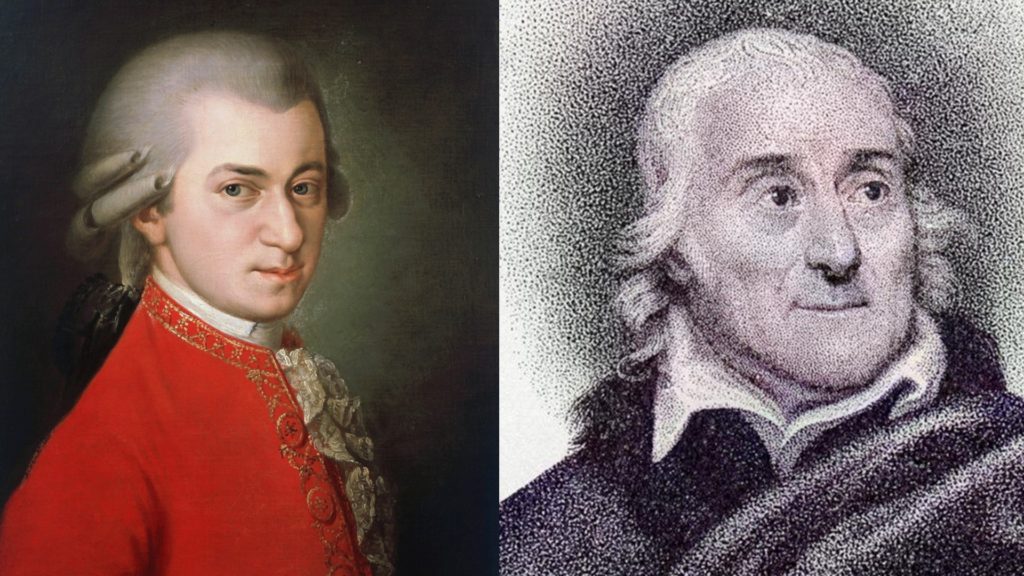Table of Contents
Introduction
In this article I would like to introduce you most practically and concisely possible to the Italian trilogy of Wolfgang Amadeus Mozart, a person in the History of Music that needs no introduction: we will talk about the works Le Nozze Di Figaro, Don Giovanni and Così Fan Tutte tracing a small historical introduction. Given the composer’s celebrity, I would like to spare you the biographical details you could find anywhere and go straight to the highlights of today’s topic. In future articles of the Musical Analysis category we will have the opportunity to deal analytically with the amazing pages of Music that we will explore here from a historical point of view: do not forget to subscribe to our blog through the email form so as not to miss the next news. Happy reading!

The Biographical Context
In Nature’s Gambit: Child Prodigies and the Development of Human Potential David Henry Feldman makes us understand how unique the case of Mozart (1756-1791) is, and he does so through the lucid description of a child who completes tasks that even adults find complex. Composing a symphony, or learning to play a keyboard instrument can take a long time: not for Mozart, who since childhood had had the opportunity and talent to try his hand at the keyboard, violin, composition of operas and symphonies. His musical training path, to tell the truth quite intense, was crossed by the early achievement of important musical goals. At the age of five Mozart composed and performed in European courts; by thirty-two he had already composed over forty symphonies. Many considered him an unsurpassed genius in Music, and we know that this elevation corresponded to just as much sloppiness in everyday life. The meeting with Da Ponte, Venetian and of Jewish origins, certainly took place after the events of 1781: in fact, it was in this year that the future librettist of the most famous Mozart opera trilogy arrived in Vienna at the court of Joseph II. It is difficult to imagine the personality of such an unusual figure: if we consider the content of the librettos written by the Venetian poet, it is very difficult for us to imagine that he was a priest.
The Marriage Of Figaro
Lorenzo Da Ponte believed in the submission of poetry to the musical text: he therefore found in the Austrian composer, who was among the first figures in the History of Music to demand an absolute prevalence of Music over the literary text, a valid collaborator. The first work we are talking about, The Marriage of Figaro, is subtitled The mad day, indicating that the events of the plot should end within a day. From this first consideration, we understand how pressing the writing of the two had to be: Da Ponte for the rapidity of the narrative rhythm, Mozart for the musical synthesis. In summary, the plot is characterized by a continuous succession of love intrigues, some of which are represented by forbidden or clandestine relationships. The themes are very often impactful: we think of the aria You who know, where Cherubino, a character who in the work represents a young man in love at the height of sexual desire that turns and extends his instincts, through singing, to Susanna and the Countess, to all women. The text of this work, in truth, will be taken from a comedy by the writer and polemicist Pierre-Augustin Caron de Beaumarchais: Da Ponte took care of the translation into Italian, which he drew from a copy of the original probably procured by Mozart himself who simultaneously wrote the Music in great secrecy. The original play had been banned by Emperor Joseph II himself because it was claimed to fuel, in some scenes, hatred between social classes. The Austrian composer took care of removing from the work the scenes of explicitly political content and proposed it to Joseph II who consented to the representation of the opera at the Burgtheater in Vienna in 1786 (theater of which we have already had the opportunity to speak in a previous article, which you can find here). Twenty years earlier, with Antonio Salieri on the harpsichord, one of the most important compositions of the opera in music scene, Gluck’s Alceste, had been performed twenty years earlier. Le Nozze Di Figaro is therefore part of this climate of reform of the theatrical work already started by the German composer, and probably part of the reception of this work was due precisely to the novelties it presented. Below I leave you a purchase suggestion, which I consider very important: the paper score of the piano reduction of the work, with which you can play and study the entire composition directly to your instrument. Immediately after, you can listen to it in the original version from YouTube via the link below. Do not forget that if you finalize the purchase of the paper score from the banner that I leave you immediately below, a small percentage will go to support this blog.
Don Giovanni
In the eighteenth century deaths on stage were very rare. Nowadays a stereotypical image of the work often passes, as of a genre in which deaths are always present. This stereotype also derives from the legacy of Don Giovanni, in which the killing of the Commander is staged: this phenomenon represents one of the first examples of staging an assassination in the musical field, a fact that should particularly surprise us if we consider that it is one of the most famous operas in the entire history of Music. Its impact and diffusion must certainly have influenced the common idea of a musical opera in the name of death and illness. In Don Giovanni the tragedy of the assassination, an element that as we have said was in itself very difficult to manage as the public was absolutely not accustomed, is artfully balanced by continuous allusions to opera buffa. In other words, with Mozart’s opera, a difficult synthesis between tragic opera and comic opera is made into music: to date, historians agree that this bold synthesis, although so new in its essential themes, has succeeded perfectly; some musicologists consider Don Giovanni the perfect and most complete synthesis between tragic work and comic work in the entire History of Music. The plot can be summarized in a nutshell as follows: the protagonist, from whom the work takes its name, is a noble womanizer; conquers them in any way, even deceiving them or by other dishonest means; he will end up receiving condemnation from the afterlife for his behaviour. The figure of the protagonist, so controversial, was actually born in literature as early as 1630 by Tirso De Molina (pseudonym of Gabriel Tellez). In his El burlador de Sevilla the plot was much more complex, in Mozart-Da Ponte we see a very reduced synthesis of the original contents. Don Giovanni is the representation of chaos, destructive forces, outrage: many historians agree that he is a character who represents not only the excesses of libertinage, but also many other archetypal images that can be linked to his excessive behavior. So excessive as to configure itself as a divine disorder. If we think about it, Don Giovanni will not be punished by ordinary mortals, as Massimo Mila already noted in his work Mozart’s Don Giovanni reading, but by the forces of the afterlife that must bother to restore the order of justice. For example, in Falstaff, cited by Mila, the punishment for the protagonist is the work of earthly characters: instead, the protagonist of the homonymous Mozart opera, unpunished by the living, receives his punishment from the afterlife. Below I leave you a purchase suggestion, which I consider very important: the paper score of the piano reduction of the work, with which you can play and study the entire composition directly to your instrument. Immediately after, you can listen to it in the original version from YouTube via the link below. Do not forget that if you finalize the purchase of the paper score from the banner here below, a small percentage will go to support this blog.
Così fan tutte – All Women Do It
Così fan tutte, or La scola degli amanti is a playful drama in two acts. With playful drama, we refer to all those works, such as the one in question or Don Giovanni, in which the comic character, prevalent in the work, is contaminated by pathetic elements aimed at creating a differentiation on a psychological level between the characters of the various characters. Così Fan Tutte was performed on the piano by Mozart himself, who invited to his home, among others, the famous composer Franz Joseph Haydn. Of course, Da Ponte is among the guests: together with him Michael Puchberg, fellow Masonic lodger of the Austrian composer. The first theatrical performance of the opera took place, as already happened for Nozze Di Figaro, at the Burgtheater in Vienna in January 1790 with a lukewarm success among the public but excellent critics. The show was soon postponed due to the death of Joseph II, which took place in February of the same year, which led to the closure of all Viennese theaters. The plot, in a nutshell, is as follows: two officers make a bet on the loyalty of their girlfriends, disguise themselves in such a way as to be unrecognizable and try to conquer them mutually, succeeding albeit with some resistance: at this point the two reveal themselves, in the repentance of the girls. The work plays on symmetrical relationships: the two couples Fiordiligi-Guglielmo and Dorabella-Ferrando are perfectly mirrored; don Alfonso and Despina also correspond to these proportions: the major theater directors study their shots on the basis of the specularity of the composition. Below I leave you a purchase suggestion, which I consider very important: the paper score of the piano reduction of the work, with which you can play and study the entire composition directly to your instrument. Immediately after, you can listen to it in the original version from YouTube via the link below. Do not forget that if you finalize the purchase of the paper score from the banner here below, a small percentage will go to support this blog.
Conclusions
That’s all for this article: as already mentioned in the introduction, we will have the opportunity to go into detail about Mozart’s works in the Musical Analysis section. Do not forget to subscribe to the blog through the appropriate pop-up form so as not to miss the notifications on upcoming publications: we will see you in tomorrow’s article.
- History Of The Piano – The Fortepiano - July 12, 2022
- Curt Sachs – History Of Organology At a Glance - July 8, 2022
- Giuseppe Verdi – Rigoletto, Il Trovatore, La Traviata - June 29, 2022
